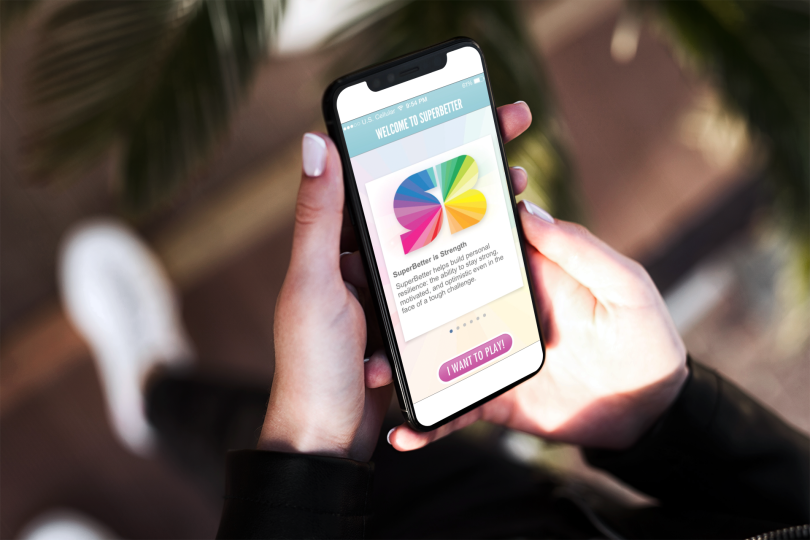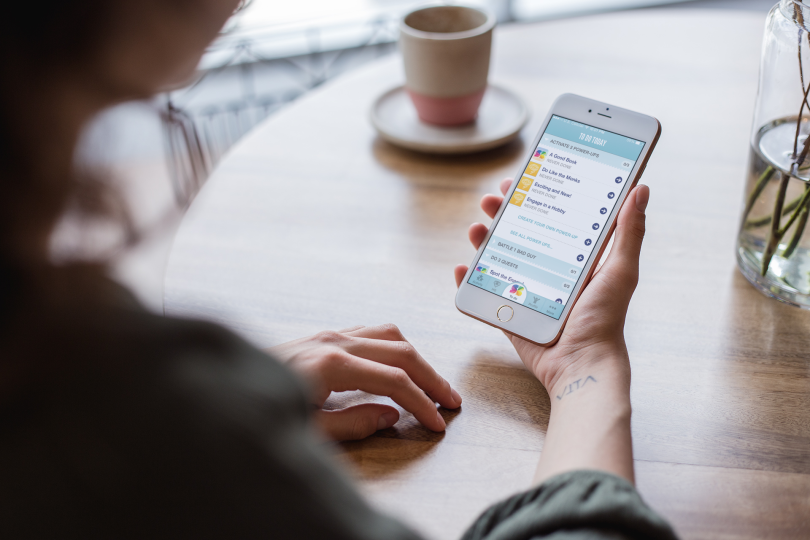Within SuperBetter, a mobile game designed to improve the player’s mental health, each user’s journey begins with a simple question: What’s your challenge?
Instead of vanquishing a dragon or thwarting an evil wizard, the options range from anxiety to chronic pain to a desire to eat healthier.
What follows will be familiar to anyone who has ever played a video game, and that’s by design. The company uses the framework of role-playing games, combining quests, power-ups and villains to motivate users to change their real-life habits.
The company calls this design method Live Gamefully, and it informs every element of its game.
“It’s a combination of the hero narrative and familiar game mechanics that can be used to empower us to be our better selves,” said Yuanbo Liu, SuperBetter’s head of product. “We play into that hero’s journey.”
While most games strive to capture user attention at all costs, SuperBetter doesn’t want its users constantly opening its app. Their goal is to support healthier habits in the real world, rather than to serve as an escape from it.
From a UX perspective that presents an interesting challenge.
How to make apps engaging, not addicting
- SuperBetter leverages game elements to motivate self-improvement. Changing habits is hard work, so SuperBetter positions the user as the hero and mental resilience-building tasks like maintaining your living space, drinking a glass of water or going on a walk as power ups and bad guys to inspire positive behavior.
- Optimize for results rather than engagement. The game limits the number of achievements a person can achieve in a day to discourage people from overloading on instant gratification. It also doesn’t punish a user for not returning to the app.
- Players can customize their experience on the app. Users are allowed to select their own challenges or create their own tasks to customize the game experience to their situations or challenges.
- Social elements are encouraging, but not competitive. Users can turn friends into allies, who support their efforts and share their achievements, but there is no mechanism for competition, which could lead to discouragement.
The origins of ‘Live Gamefully’
SuperBetter founder and Chief Science Officer Jane McGonigal established the Live Gamefully method in 2009 to help her combat the depression and anxiety she experienced after suffering from a severe concussion.
As a trained game designer, McGonigal incorporated seven psychological strengths designed to build emotional resilience and reduce stress into the framework of a game. Those strengths include:
- A challenge mindset
- Emotional control
- Mental flexibility
- A sense of purpose
- Social connectedness
- Self-efficacy
- Optimism
Every time she drank a glass of water or took a walk around the block, she’d get the satisfaction of leveling her character up or defeating a bad guy.
The game elements not only helped McGonigal recover, but its mental health impact has been verified in both randomized controlled studies and clinical trials.
“It’s a combination of the hero narrative and familiar game mechanics that can be used to empower us to be our better selves.”
Researchers in a University of Pennsylvania study published in Games for Health concluded that SuperBetter helped reduce depression in a controlled trial. Another study by The Ohio State University Wexner Health School found that SuperBetter’s game design could improve concussion recovery for teens.

CEO Keith Wakeman joined forces with McGonigal in 2015 to help SuperBetter reach a wider audience. To Wakeman, the app provides a promising alternative to current app design trends. While apps that manipulate user attention with likes or endless news feeds keep advertisers happy, he doesn’t believe it’s a sustainable model.
“It won’t be many more years people burn out on the attention economy,” Wakeman said. “People will figure out if they’re not feeling as good because they’re on their phone. They’ll look for solutions.”
What sets SuperBetter apart is its use of gaming to improve user outcomes rather than increase time on page, Wakeman said.

Striking the right balance of dopamine and wellness
For SuperBetter to work, the design must result in a fun game that also motivates people to take action in their own lives.
Lean too far in the first direction, and you may create a game that relies on empty dopamine hits with dwindling impact. Yet solely providing self-help advice can break the game spell and discourage users from returning to the app.
“It won’t be many more years people burn out on the attention economy.”
To find that balance, every design decision at SuperBetter starts with examining how it will engage users, said Liu. After all, no matter how useful the app is, people won’t return to it if it isn’t fun.

The game framework gives the company an edge in this challenge because games are adept at motivating people to do different tasks, Liu said. In SuperBetter's case, it allows them to reframe healthy habits as an adventure.
“We want to lower the requirements of initiative from the user,” Liu said.
In the battle against the “Sticky Chair,” users are challenged to stand up and take one step away from the couch to avoid being sedentary all day — a common struggle for those who suffer from depression. In a power-up activity, users are challenged to drink a glass of water. For every challenge the user completes, they earn badges, gain resilience points and build up their physical, mental, emotional and social stats.
“The goal is to guide people’s behaviors by creating these different kinds of motivational mechanisms,” Liu said. “It’s not going to be so powerful that it makes you think going out for a run in 30-degree weather is fun, but it can get you out of the mindset that doing those things are a responsibility.”

Introducing a social element without inviting comparisons or competition
From a social level, users can post their achievements and connect with friends or other players.
But the company’s design principles also inform the choices they don’t make. There’s a reason the company refuses to use leaderboards, provide engagement charts or dock users points for not using the app.
Every UX decision is geared toward building a person up, Wakeman said. Each of those popular gaming elements can discourage a person or encourage them to maximize their scores, rather than focus on behaviors that actually help them.
“We want people to have fun and have experiences that they feel are meaningful.”
While it might not make for as addicting of an experience as say, “Candy Crush,” Liu said adhering to those principles ensures the company creates intrinsic motivators that engage users on a deeper level.
“We want people to have fun and have experiences that they feel are meaningful,” Liu said. “As a result, they tend to come back.”
Tailoring the game to user preferences, through feedback and options
Since what is meaningful changes with each person, the company has worked to make the experience as customizable as possible. Users can create their own challenges or select from a wide variety of packs that are relevant to them.
After finishing each task, users are asked to rate how challenging they found it. Their answers shape how much reward they receive for it, and what tasks they receive next. They can also choose whether they want mobile notifications or emails.
“We try to create customization based on people’s preferences,” Liu said.
The Live Gamefully method has also been adapted for different versions of SuperBetter. The company licensed its design model to Abound Wellness to create a work-focused version of the game called SuperBetter At Work. The company is also partnering with college campuses to create a SuperBetter On Campus version. This new version will be curated to the needs and challenges of students to help reduce dropout rates.
“The goal is to guide people's behaviors by creating these different kinds of motivational mechanisms.”
Currently, only 58 percent of students are graduating college over six years, according to a U.S. News and World Report. While the primary reason is a lack of financial support, other factors like academic support, stress and social engagement can play a role.
Liu and the design team have started the process of talking to college students and asking how they define success and what they need to be successful. This will inform the challenges players receive, and how they complete them.
While the app is in development, Liu said they are thinking about creating joint challenges that encourage students to engage with each other or a campus organization to complete a task. The team is also thinking about creating an integration with SnapChat to reach users where they most spend their time.

Gathering feedback in the app and on Facebook
With every design aimed at improving a user’s life, the company relies heavily on user feedback to shape its experience.
Right now, the team frequently gathers feedback from a wide and established user base on its app and on its Facebook group page. Their responses give Liu and his team perspective and ensure their design decisions are supporting its goal of helping people improve their lives.
“We know that’s the best source of insight we can get about the quality of the product,” Liu said.
But Liu also acknowledges the limitations of relying solely on qualitative feedback.
“For us, developing a behavior changing experience, nothing is more important than learning how users are actually using the app.”
It can be hard to track user metrics beyond the anecdotal experiences people are willing to share. That may change, however, with the On Campus app. Through that version, the company may track user engagement internally and provide that information to campus guidance counselors.
“For certain products, the experts dominate product development,” Liu said. “For us, developing a behavior changing experience, nothing is more important than learning how users are actually using the app.”




